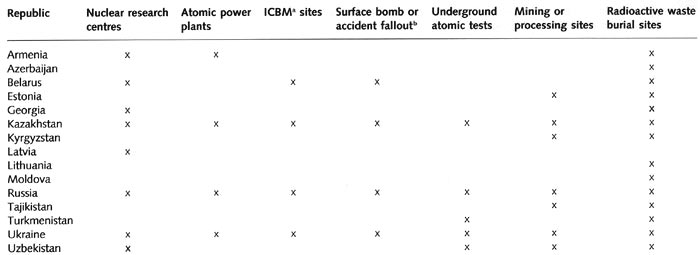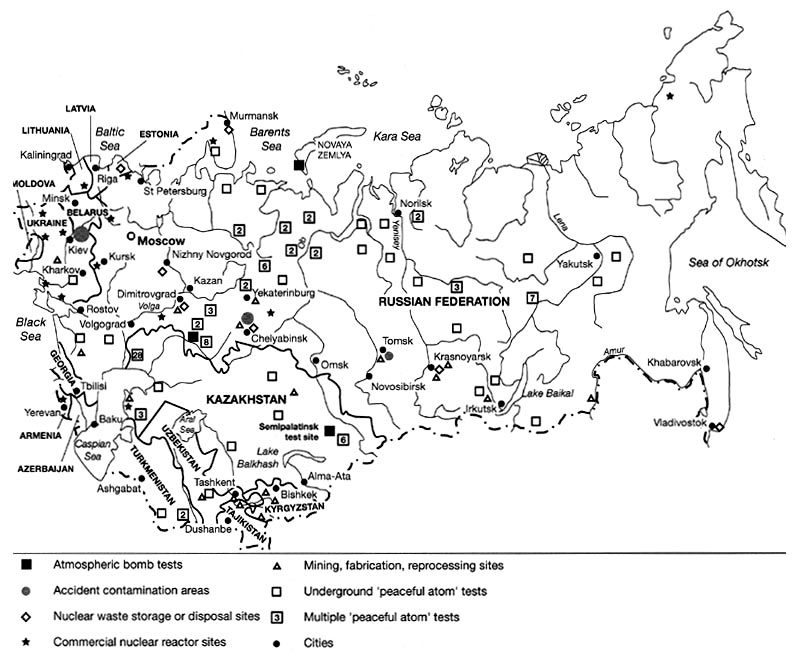Please put an active hyperlink to our site (www.rusnature.info) when you copy the materials from this page
Environmental problems of Northern Eurasia
Radioactive Contamination
<<< Environmental Problems Index | Nuclear Facilities in the Russian Federation >>>
From Estonia on the Baltic Sea to Russia's Far East on the Pacific, the former Soviet
Union (FSU) created both an economy and a military establishment that involved intensive
development of nuclear facilities. An unfortunate consequence of this has been that in
dozens of locations both land and water are polluted by radioactive by-products of nuclear
energy production and military weaponry. Thousands of people are sick or dead from
radioactive causes, millions of hectares are too polluted for normal human activity, and
the resources needed to clean up this dangerous situation are staggering and at present
unobtainable. Of all the legacies left by the USSR, almost certainly the most costly in
the long run will be nuclear contamination.
Overview
In 1945, the United States was the only nation possessing the atomic bomb. To Josef
Stalin and his generals, this was unacceptable. To them, the USSR had to be equal, and
preferably superior, to its ideological enemy in every way, and most certainly in
strategic military capability. This meant acquiring nuclear weapons as quickly as
possible, at any cost.
A crash programme was begun, and before the end of the 1940s, the Soviet Union had
ended America's monopoly on nuclear weapons. But Stalin did not want just a few nuclear
devices, he wanted thousands, and to achieve this, a vast array of mining, processing,
manufacturing, and disposal sites had to be developed. And, in Stalin's usual manner, all
this had to be done in total secrecy. Across the Soviet Union, secret uranium mines,
secret enrichment plants, secret nuclear power plants, secret bomb production facilities,
secret waste storage sites, and even entire secret cities were built with impressive
speed, but often with far from impressive safety procedures. Eventually, as the saying
goes, the piper would have to be paid.
The potential sources of nuclear contamination in any country with both civilian and
military atomic energy programmes are numerous. A review of the nuclear fuel cycle might
be useful at this point. The nuclear fuel cycle starts with mining uranium ore, generally
with nearby concentrator facilities. Next, the ore travels to enrichment plants, where the
percentage of fissionable isotopes is increased. It is then processed into either fuel
rods for nuclear reactors, or into bomb-grade uranium having chain reaction capability.
After nuclear fuel has been used, it must be reprocessed so that it may be safely stored
in designated repositories. Reprocessing produces by-products that are highly radioactive
and which must be safely isolated from contact with the biosphere, in some cases for
thousands of years.
The Soviet Union constructed a large number of nuclear power plant complexes for both
civilian and military purposes; when operated properly, background levels of radiation at
these stations are not exceeded. At the other extreme, all 'nuclear powers' utilize
restricted sites for testing atomic weapons, and the former atmospheric tests produced
highly contaminated regions. Over one hundred locations also exist in the former Soviet
republics where nuclear bombs were exploded underground for economic reasons, such as
stimulating oil and gas production, or creating storage cavities or surface depressions;
these were the so-called 'peaceful atom' projects (also experimented with by the United
States). Finally, there are those regions grossly contaminated by accidental releases of
radiation, sometimes over vast areas, such as from Chernobyl.
Every former Soviet republic had at least one facility or location involved with
nuclear development, as shown in Table 19.1 and Figure 19.1. Latvia, Azerbaijan, and
Moldova were the least affected, with just one site each, none of which involves
significant contamination. However, four republics - Russia, the Ukraine, Belarus, and
Kazakhstan - each have at least one region of serious high-level contamination, as well as
numerous potential ones. The status of nuclear actives and problems in the Soviet
successor states has been widely discussed in recent years (e.g., Potter, 1993; Pryde and
Bradley, 1994; Donnay et al, 1995; Bradley, 1997).

Table 19.1 Sources of radioactive wastes in the former Soviet republics
ICBM - intercontinental ballistic missile

Fig. 19.1 Radioactive waste and contamination in the former Soviet
republics. After Pryde and Bradley (1994)
Sites with moderate to severe radioactive contamination can be found in over a hundred
locations across the FSU, including in its offshore waters. The nature and extent of such
contamination in the former Soviet republics has recently been examined in great detail in
the most comprehensive work on this subject to appear to date (Bradley, 1997).
The next two sections of this chapter will briefly describe the nuclear installations
to be found in each of the fifteen former Soviet republics. Following this, an examination
of the most highly contaminated regions of the FSU will be conducted.
<<< Environmental Problems Index | Nuclear Facilities in the Russian Federation >>>
Contents of the Radioactive Contamination
section:
Other sections of Environmental Problems of Nortern Eurasia:
|
|